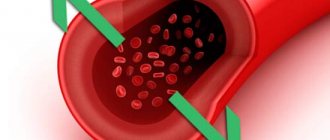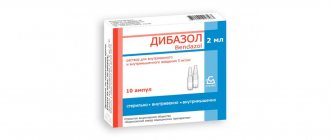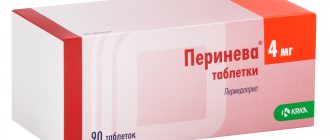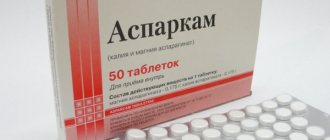There are many drugs that are used to normalize blood pressure. Physiotens is one of them. Next, you will learn how Physiotens works, how to use it correctly, what contraindications and side effects it has.
Hypertension is a pathology that is gaining more and more momentum every day. The reasons for this factor are different sources - these are stressful conditions, unhealthy diet, intense rhythm of life. This factor cannot be ignored. After all, hypertension can be life-threatening and cause death due to severe complications. In pharmacies you can find various pills to alleviate the patient’s condition. Physiotens tablets have an effective effect, reducing blood pressure to normal levels if you choose the right dosage for the patient. Next, we will study their instructions in detail.
Physiotens tablets 0.2, 0.4 mg: instructions for use, dosages for hypertensive crisis
Drugs in dosages of 0.2; 0.4 milligrams are produced in tablet form. They are convenient to use. The main component of Physiotens is a component such as moxonidine. Its quantity is determined by the dosage of the pharmaceutical product, respectively: 0.2-0.3 mg. The pills also contain other auxiliary components (talc, macrogol, titanium dioxide, etc.). The dosage form is dispensed according to a doctor's prescription; it is recommended to store the pills for no more than two to three years, this is directly dependent on the packaging material.
Physiotens from pressure
The tablets are taken orally, it does not matter - before or after meals. Dosages are adjusted by a specialist doctor individually for each patient. Initially, it is recommended to start using pills with a low dosage of moxonidine - 0.2 mg , and then increase the amount of the drug if necessary. You are allowed to drink no more than 0.4 mg of Physiotens at a time, and no more than 0.6 mg per day . This dosage is divided into two doses. In case of kidney disease, the dosage should not be exceeded - 0.4 mg per day; in such cases, you can drink 0.2 mg once.
IMPORTANT : Be sure to remember that you should not exceed the recommended dose of the drug, which is 0.6 milligrams per day. And even during serious attacks, you should not take two 0.3 tablets at a time; divide them into two doses.
Physiotens 0.4 mg No. 14 tablet p.o.
Instructions for medical use of the drug Physiotens® Trade name Physiotens® International nonproprietary name Moxonidine Dosage form Film-coated tablets, 0.2 mg, 0.4 mg Composition One tablet contains the active substance - moxonidine 0.2 mg, or 0.4 mg, excipients: lactose monohydrate, povidone K25, crospovidone, magnesium stearate, shell composition: hypromellose 6 mPas, ethylcellulose 30% aqueous dispersion (in terms of dry matter), macrogol 6000, talc, red iron (III) oxide (E172), titanium dioxide (E171). Description Tablets are round in shape, with a biconvex surface, light pink film-coated, with “0.2” engraved on one side (for a dosage of 0.2 mg). Tablets are round in shape, with a biconvex surface, film-coated, pale red in color, with “0.4” engraved on one side (dosage 0.4 mg). Pharmacotherapeutic group Antihypertensive drugs. Central agonists. Alpha 2-adrenergic agonists are central, imidazoline derivatives. Moxonidine. ATC code C02AC05 Pharmacological properties Pharmacokinetics Absorption. When taken orally, moxonidine is rapidly and almost completely (Tmax about 1 hour) absorbed from the upper gastrointestinal tract. Absolute bioavailability is 88%, indicating the absence of primary hepatic metabolism. Food intake does not affect the pharmacokinetics of moxonidine. The binding to plasma proteins is 7.2%. Biotransformation. Only one metabolite of moxonidine is detected in the blood - dehydromoxonidine. Its pharmacological activity is 10 times less than moxonidine. Excretion. Within 24 hours, more than 78% of moxonidine is excreted by the kidneys, and 13% as dehydromoxonidine. Other, less significant metabolites are found in the urine in amounts of about 8% of the administered dose. Less than 1% of the dose is excreted in the feces in the form of metabolites: 4.5 dehydromoxonidine and guanidine derivatives. The half-life of moxonidine and its main metabolite is 2.5 and 5 hours, respectively. Pharmacokinetics in patients with arterial hypertension In patients with arterial hypertension, no changes in pharmacokinetics were detected. Pharmacokinetics in the Elderly In elderly patients, differences in the pharmacokinetics of moxonidine are observed compared to younger individuals, mainly due to reduced metabolic activity and/or increased bioavailability in the elderly. However, these pharmacokinetic differences are not clinically significant. Pharmacokinetics in children and adolescents under 18 years of age Pharmacokinetic studies in children and adolescents have not been conducted. Pharmacokinetics in renal failure The elimination of moxonidine is significantly correlated with creatinine clearance (CC). In patients with moderate renal failure (glomerular filtration rate (GFR) 30-60 ml/min), steady-state plasma concentrations and terminal half-life are, respectively, 2 and 1.5 times higher than in hypertensive patients with normal renal function ( GFR >90 ml/min). Moreover, the maximum plasma concentrations of moxonidine are 1.5-2 times higher in patients with moderate renal failure. In patients with severe renal impairment (GFR < 30 ml/min), steady-state plasma concentrations and terminal half-life are approximately 3 times higher than in hypertensive patients with normal renal function. Taking multiple doses does not lead to the accumulation of moxonidine in the body of patients in this group. In patients with end-stage renal disease (GFR < 10 mL/min) on dialysis, the area under the curve (AUC) and terminal half-life are 6 and 4 times higher, respectively, than in patients with normal renal function. Therefore, the dose of moxonidine in patients with renal failure should be titrated according to individual needs. Moxonidine is excreted to a small extent during hemodialysis. Pharmacodynamics Physiotens® is an antihypertensive drug. Available experimental data show that the localization of action of moxonidine is the central nervous system (CNS). Moxonidine has been shown to selectively stimulate imidazoline receptors in the brainstem. Imidazoline - sensitive receptors are concentrated in the rostral part of the ventrolateral part of the medulla oblongata - an area that is considered the center of regulation of the peripheral sympathetic nervous system. When imidazoline receptors are stimulated, the activity of the sympathetic nervous system decreases and blood pressure decreases. Moxonidine differs from other sympatholytic antihypertensive drugs by its low affinity for α2-adrenergic receptors compared to imidazoline receptors. This may explain the low likelihood of sedation and dry mouth with moxonidine. Moxonidine reduces blood pressure by reducing systemic vascular resistance, which has been proven in clinical studies. The antihypertensive effect of moxonidine has been demonstrated in double-blind, placebo-controlled, randomized studies. Published data show that in patients with hypertension and left ventricular hypertrophy (LVH), for similar blood pressure reduction, the use of an angiotensin II antagonist with moxonidine resulted in improved regression of LVH compared with the use of a combination of a thiazide diuretic and a calcium channel blocker. Moxonidine improves tissue sensitivity to insulin by 21% compared with placebo in obese and insulin-resistant patients with moderate hypertension. Indications for use: arterial hypertension. Method of administration and dosage. Tablets are taken orally with a sufficient amount of water, regardless of meals. In most cases, the initial dose of Physiotenza® is 0.2 mg per day; the maximum daily dose, which should be divided into 2 doses, is 0.6 mg. The maximum single dose is 0.4 mg. The dose and course of treatment are selected individually, depending on the clinical response. In patients with moderate or severe renal impairment, the initial dose of moxonidine is 0.2 mg per day. If necessary and well tolerated in patients with moderate renal failure, the dose of moxonidine can be increased to 0.4 mg per day, in patients with severe renal failure - up to 0.3 mg per day. In patients on hemodialysis, the initial dose is 0.2 mg per day. If necessary and well tolerated, the dose can be increased to 0.4 mg per day. The use of moxonidine in children and adolescents under 18 years of age is not recommended due to the lack of data on safety and effectiveness. Side effects Very common - dry mouth Common - dizziness, headache, drowsiness, insomnia, asthenia - diarrhea, nausea/vomiting, dyspepsia - rash, itching - back pain Uncommon - bradycardia, hypotension, including orthostatic hypotension - angioedema, peripheral swelling - pain in the neck - tinnitus - nervousness, fainting Contraindications - hypersensitivity to the components of the drug - sick sinus syndrome - bradycardia (resting heart rate less than 50 per minute) - atrioventricular block II or III degree - heart failure - children's and adolescence up to 18 years - pregnancy and lactation Drug interactions When Physiotens® is used together with other antihypertensive drugs, the effect is mutually enhanced. Since tricyclic antidepressants can reduce the effectiveness of centrally acting antihypertensive drugs, simultaneous use of Physiotens® with drugs of this group is not recommended. Physiotens® may enhance the sedative effect of tricyclic antidepressants (their coadministration should be avoided), tranquilizers, alcohol, sedatives and hypnotics. Physiotens® moderately improves reduced cognitive performance in patients taking lorazepam. Physiotens® enhances the sedative effect of benzodiazepines when taken together. Since Physiotens® is eliminated through tubular excretion, interaction with drugs that have the same route of elimination cannot be ruled out. Special instructions Physiotens® is prescribed with caution in patients with a possible predisposition to the development of atrioventricular block and in patients with 1st degree atrioventricular block in order to avoid bradycardia. Patients with severe coronary artery disease or unstable angina require careful monitoring, since experience with Physiotens® in this group of patients is limited. Particular caution must be exercised when using moxonidine in patients with severe coronary heart disease or unstable angina, since experience with the drug in this category of patients is limited. It is recommended to take precautions when prescribing Physiotens® to patients with renal failure, since moxonidine is excreted by the kidneys. These patients require careful dose selection, especially at the beginning of therapy. The initial dose of moxonidine should be 0.2 mg per day and, if clinically indicated and well tolerated, can be increased to a maximum of 0.4 mg per day in patients with moderate renal impairment (GFR > 30 ml/min but < 60 ml/min) and maximum up to 0.3 mg per day in patients with severe renal failure (GFR < 30 ml/min). If Physiotens® is taken in combination with a drug from the group of beta-blockers, then if it is necessary to cancel both drugs, first cancel the beta-blocker and only after a few days - Physiotens®. There is no withdrawal syndrome observed when stopping Physiotens. However, treatment should not be abruptly interrupted; It is recommended to gradually reduce the dose over two weeks. Patients with congenital galactose intolerance, Lapp lactase deficiency or glucose-galactose malabsorption should not take Physiotens®. Features of the effect of the drug on the ability to drive a vehicle or potentially dangerous mechanisms During the treatment period, it is necessary to refrain from driving vehicles and engaging in potentially hazardous activities that require increased concentration and speed of psychomotor reactions. Overdose Symptoms: headache, sedation, drowsiness, hypotension, dizziness, asthenia, bradycardia, dry mouth, vomiting, fatigue and stomach pain. In cases of serious overdose, disturbances of consciousness and respiratory depression may occur. A short-term increase in blood pressure, tachycardia, and hyperglycemia are also potentially possible. Treatment: There are no specific antidotes. Hypotension may require dopamine administration and measures to maintain circulation, including infusion of solutions. Atropine can be used to eliminate bradycardia. Alpha-adrenergic antagonists may reduce or eliminate paradoxical hypertension. Release form and packaging 14 or 28 tablets are placed in a blister pack made of polyvinyl chloride film and aluminum foil. 1 blister pack together with instructions for medical use in the state and Russian languages are placed in a cardboard pack. Storage conditions Store at a temperature not exceeding 25 ° C (for 0.2 mg). Store at a temperature not exceeding 30 °C (for 0.4 mg). Keep out of the reach of children! Shelf life: 2 years (for a dosage of 0.2 mg) 3 years (for a dosage of 0.4 mg) Do not use after the expiration date indicated on the package. Conditions for dispensing from pharmacies By prescription Name and country of the manufacturing organization Abbott Healthcare SAS, France Route de Belleville, Maillard 01400, Châtillon-sur-Chalaron Name and country of the holder of the marketing authorization Abbott Laboratories GmbH, Hannover, Germany Name and country of the packaging organization Abbott Healthcare CAC, France Route de Belleville, Maillard 01400, Chatillon-sur-Chalaron Address of the organization that accepts claims from consumers regarding product quality in the Republic of Kazakhstan Abbott Kazakhstan LLP 050059, Almaty, Dostyk Ave. 117/6, Business. tel., fax. Email
How to take Physiotens correctly: under the tongue or with water?
When taking Physiotens, it is recommended to monitor your blood pressure and measure your pulse. To eliminate the manifestations of the disease, beta-adrenergic receptor blockers are taken along with Physiotens. If the patient needs to stop taking Physiotens, then first stop taking the blockers, and then the drug itself.
Rules for taking Phytosiotens
According to the instructions, the pills should be taken with water, but if a more effective effect of the tablets is required, then it is better to dissolve the tablet under the tongue. The active substances will penetrate the bloodstream, which significantly accelerates the normalization of blood pressure in patients. Use this method of taking the drug when a person’s blood pressure is too high.
IMPORTANT : Physiotens can be taken regardless of meal time. The required level of the main substance of the drug is achieved when only seven percent of moxonidine binds to plasma protein molecules. The highest level of the chemical component is recorded after 1.5-2 hours. The medicine comes out through the kidneys.
Physiotens®
Suction
After oral administration, moxonidine is rapidly and almost completely absorbed from the upper gastrointestinal tract. Absolute bioavailability is approximately 88%, indicating no significant first-pass effect.
The time to reach maximum concentration is about 1 hour. Food intake does not affect the pharmacokinetics of the drug.
Distribution
The binding to plasma proteins is 7.2%.
Metabolism
The main metabolite is dehydrogenated moxonidine. The pharmacodynamic activity of dehydrogenated moxonidine is about 10% compared to moxonidine.
Removal
The half-life (T1/2) of moxonidine and metabolite is 2.5 and 5 hours, respectively. Within 24 hours, over 90% of moxonidine is excreted by the kidneys (about 78% unchanged and 13% as dehydriromoxonidine, other metabolites in the urine do not exceed 8% of the dose taken). Less than 1% of the dose is excreted through the intestines.
Pharmacokinetics in patients with arterial hypertension
Compared with healthy volunteers, patients with arterial hypertension show no changes in the pharmacokinetics of moxonidine.
Pharmacokinetics in old age
Clinically insignificant changes in the pharmacokinetic parameters of moxonidine were noted in elderly patients, probably due to a decrease in the intensity of its metabolism and/or slightly higher bioavailability.
Pharmacokinetics in children
Moxonidine is not recommended for use in persons under 18 years of age, and therefore no pharmacokinetic studies have been conducted in this group.
Pharmacokinetics in renal failure
Moxonidine excretion is significantly correlated with creatinine clearance (CC). In patients with moderate renal failure (creatinine clearance in the range of 30-60 ml/min), steady-state plasma concentrations and final T1/2 are approximately 2 and 1.5 times higher than in individuals with normal renal function (creatinine clearance more than 90 ml/min). min).
In patients with severe renal failure (creatinine clearance less than 30 ml/min), steady-state plasma concentrations and final T1/2 are 3 times higher than in patients with normal renal function.
The administration of multiple doses of moxonidine leads to predictable accumulation in the body of patients with moderate and severe renal failure.
In patients with end-stage renal failure (creatinine clearance less than 10 ml/min) on hemodialysis, steady-state plasma concentrations and final T1/2 are 6 and 4 times higher, respectively, than in patients with normal renal function.
In patients with moderate renal failure, the maximum concentration of moxonidine in the blood plasma is 1.5-2 times higher.
In patients with impaired renal function, the dosage should be adjusted individually. Moxonidine is excreted to a small extent during hemodialysis.
Physiotens: contraindications, side effects
Each pharmaceutical drug has its own advantages and contraindications; it is these contraindications that patients should pay attention to when choosing this or that drug. It is better not to use Physiotens in patients of the following categories:
- for patients under 18 years of age
- women in an interesting position and breastfeeding
- with bradycardia, if the pulse is less than fifty beats
- the patient has a disease in the form of heart failure in all forms of its manifestation
- for kidney pathologies
- when you are allergic to a medicine.
The official instructions say that Physiotens should not be given to teenagers under 18 years of age, but sometimes doctors lower this threshold, recommending taking the pills as early as 16 years of age. It is prescribed to patients if they have allergic reactions to the actions of other pills.
Can pregnant women drink Physiotens?
There is another list of contraindications to the use of tablets on an ongoing basis. But you can take Physiotens once. These include:
- Problems with lactose absorption, glucose malabsorption.
- Liver failure, various other organ pathologies, since the drug has a negative effect on the liver.
- Raynaud's disease, Parkinson's disease, epilepsy.
It is recommended to use the medicine with caution or once and for depression. Doctors do not advise patients with low weight to take pills.
Instructions for use PHYSIOTENS®
Suction
After oral administration, moxonidine is rapidly and almost completely absorbed from the upper gastrointestinal tract. Absolute bioavailability is approximately 88%, indicating no significant first-pass metabolism through the liver. The time to reach Cmax is about 1 hour. Food intake does not affect the pharmacokinetics of the drug.
Distribution
Plasma protein binding, as determined in vivo, is 7.2%.
Metabolism
Based on the totality of analyses, only one metabolite of moxonidine was detected - dehydrogenated moxonidine. The pharmacodynamic activity of dehydrogenated moxonidine is about 10% compared to moxonidine.
Removal
T1/2 of moxonidine and metabolite is 2.5 and 5 hours, respectively. Within 24 hours, 78% of the administered dose of the drug is excreted unchanged in the urine and 13% as dehydrated moxonidine; other metabolites in the urine account for approximately 8% of the dose taken. Less than 1% of the dose is excreted through the intestines.
Pharmacokinetics in special clinical situations
Compared with healthy volunteers, patients with arterial hypertension show no changes in the pharmacokinetics of moxonidine.
Clinically insignificant changes in the pharmacokinetic parameters of moxonidine were noted in elderly patients, probably due to a decrease in the intensity of its metabolism and/or slightly higher bioavailability.
Moxonidine is not recommended for use in children and adolescents under the age of 18 years, and therefore pharmacokinetic studies have not been conducted in this group.
Moxonidine excretion is significantly correlated with CC. In patients with moderate renal failure (creatinine clearance 30-60 ml/min), steady-state plasma concentrations and final T1/2 are approximately 2 and 1.5 times higher than in individuals with normal renal function (creatinine clearance more than 90 ml/min). In patients with severe renal failure (creatinine clearance less than 30 ml/min), steady-state plasma concentrations and final T1/2 are 3 times higher than in patients with normal renal function. The administration of multiple doses of moxonidine leads to predictable accumulation in the body of patients with moderate and severe renal failure.
In patients with end-stage renal failure (creatinine clearance less than 10 ml/min) on hemodialysis, the AUC value and final T1/2 are 6 and 4 times higher, respectively, than in patients with normal renal function.
In patients with impaired renal function, the dose should be adjusted individually.
Moxonidine is excreted to a small extent during hemodialysis.
How long can you take Physiotens without a break? Can you drink it on an ongoing basis?
Physiotens, as already mentioned, should be used by patients in small dosages. Otherwise, various side effects may occur. You will need to strictly monitor your pill intake and evaluate your condition, especially with long courses of taking the medication. You can take Physiotens for a long time, but on the condition that you measure your pulse and blood pressure several times daily.
The drug is used if the patient has type 2 or 3 hypertension; before use, consult your doctor about the dosage of the drug. The cardiologist must prescribe a comprehensive treatment regimen. Hypertension cannot be treated with Physiotens alone. A specialist doctor should also stop taking pills. This will take two weeks; you will again need to monitor your pulse and blood pressure.
Contraindications for use
The drug should not be prescribed to patients who suffer from sinus node weakness, severe bradycardia, lactose intolerance, or have hypersensitivity to the active substance of the drug.
Warning. Since no studies have been carried out regarding the effect of the main substance of the drug on the fetus, the drug in question is strictly forbidden to be taken by women in an interesting position.
You should be careful when taking Physiotens, as it can cause dizziness, sleep disturbances, headaches, and low blood pressure.
Physiotens: overdose
The dosages of the drug have already been discussed, but unfortunately there are cases when even 0.4 mg causes an overdose. Much depends on the individual characteristics of the human body. It is a pity that there is no antidote to eliminate the symptoms of overdose. In case of overdose, if necessary, doctors prescribe Dopamine and Atropine.
Side effects of tablets
If you take Physiotens in large dosages, suppression of the nervous system may occur, which will cause increased drowsiness, weakness in muscle tissue, and increased glucose in the bloodstream. There may even be a drop in blood pressure, a feeling of dry mouth, and pain in the stomach. To alleviate the patient’s condition in this case, it is necessary to take appropriate measures:
- give the patient still water, not just once, but drink in small portions, as often as possible
- for severe symptoms of bradycardia, use Atropine
- if the pressure is too low, then give a Dopamine injection.
In some cases, patients from an overdose of Physiotens lose consciousness, feel nausea, diarrhea appears, and darken their vision. There are also skin rashes due to allergies, itching, and insomnia.
Physiotens: is it possible to split the tablet?
Most often, the tablet is split to get a smaller dosage or to save money. After all, a drug with a higher dosage, if used in half a tablet, will be cheaper than buying the required dosage. Physiotens can be divided in half.
During the research, scientists found that there were no problems with dividing blood pressure medications. This was established after a survey of 1618 patients. Only 4 percent of respondents said that the effect of taking half a tablet reduced the quality of their condition.
Operating principle
Physiotens is an original drug manufactured by Abbott Products, located in the United States. This is a powerful, innovative drug, the main ingredient of which is moxonidine. The medication does not belong to the first group of drugs that have a positive effect on the body, gradually normalizing high blood pressure. However, there is a certain category of patients for whom this medicine is the drug of choice. This is explained not only by a pronounced hypotensive effect, but also by a strong influence on the metabolic process. A large number of clinical studies have shown that the active substance of the drug can prevent the development of insulin resistance. It can also quickly normalize the metabolic processes occurring in the body and eliminate any disturbances.
When using a drug called Physiotens, patients experience a dual mechanism of action. It provides not only short-term (usually through its effect on the sympathetic centers of the brain), but also long-term control of blood pressure by suppressing the release of renin. This is an enzyme that regulates high blood pressure. While taking the medication, the excretory function of the urinary system, in particular the kidneys, significantly improves. In real clinical practice, a medicine called Physiotens is often used as part of combination therapy.
Moxonidine is the active component of the drug, which differs significantly from classical drugs in that it acts for a long time over several hours (6-12 hours).
As for the features of the action, Physiotens has a strong stimulating effect on imidazoline receptors, which are located in the medulla oblongata. They play an important role in the central regulation of blood pressure. Modulate the activity of the sympatho-adrenal system. These receptors are also responsible for regulating the production of pancreatic hormones. The medication in question and all its analogues have therapeutic effects such as:
- Reduced hyperactivity of the sympathetic nervous system.
- Increased sensitivity of peripheral tissues to insulin.
- Significant improvement in fat metabolism indicators.
- Minimizing the concentration of glucose and leptin, a hormone in adipose tissue that is responsible for energy metabolism.
The drug significantly reduces the content of renin, aldosterone and angiotensin II in the blood plasma. These effects are extremely important for individuals who suffer from surges in blood pressure. It should be noted that a gradual decrease in the activity of the renin-angiotensin-aldosterone system can prevent the development and progression of all kinds of structural changes in the left ventricle of the heart muscle, as well as arteries, veins and capillaries.
In the course of research, while taking Physiotens, results were obtained that indicate a significant improvement in the diastolic function of the left ventricle of the heart muscle. If the patient took the medication for a long time, it was possible to reduce the increase in volume (hypertrophy) of the left ventricle.
Another interesting feature of the drug was discovered - if the initial blood pressure is very high, then it decreases more effectively than with a slight deviation from the norm. It is because of this that the possibility of eliminating the hypertensive crisis was considered.
Undesirable side effects such as dry mucous membranes and strong sedation are practically not found with the drug in question. This helps improve the tolerability of the medication.
Physiotens or Moxonidine or Capoten: which is better, more effective?
It is impossible to say which drug is better for a particular patient. After all, people have different perceptions of different types of tablets. For some, Physiotens is not suitable at all, and for others, Capoten is not suitable. But if we judge the effectiveness of the drugs in general, then Physiotens and Moxonidine still have a better chance of success. The effect of using these drugs is stronger than that of Capoten. In addition to lowering blood pressure, the patient’s headache also stops hurting and his condition normalizes for a long time.
Capoten is a remedy that reduces blood pressure within 20-25 minutes, but its effectiveness lasts only six hours in a row. Therefore, hypertensive patients should always have Capoten in their first aid kit.
Kapoten - instructions for use
Capoten is suitable for patients with type 2 hypertension. It gently reduces the load on the heart and regulates the synthesis reaction in the adrenal glands. Moxidin and Physiotens are drugs with a similar active ingredient, so the tablets have the same effect.
The principle of action of Moxonidine
IMPORTANT : You cannot use blood pressure medications haphazardly and uncontrollably. This threatens irreparable harm to the patient’s body and worsening the condition. And if you decide to use the pills without consulting a doctor, then read the instructions carefully, pay attention to the rules of administration and contraindications.
PHYSIOTENS
Hypertension and excess weight: risk factors requiring a special therapeutic approach
Risk factors that significantly influence the development of cardiac diseases are quite well known today. Thus, the main factors determining the sharp increase in the risk of deaths include increased blood pressure and obesity. With the advent of new scientific data, approaches to their prevention and treatment are changing, and new medical and surgical methods are emerging to level out their impact. In particular, a symposium organized by the successful and actively developing pharmaceutical company Solway Pharma . The symposium was held in Moscow on October 12, 2006 as part of the Russian National Congress of Cardiologists. The theme of the symposium: “Hypertension and excess weight: risk factors that require a special therapeutic approach.” Opening the symposium, the chairman, Professor I.E. Chazova noted that all over the world every year there are more and more patients with arterial hypertension and most of them are overweight. In changed living conditions, the problem of obesity is high, and hypertension is inextricably linked with obesity, which determines the need for a special therapeutic approach to such patients.
The first report of the symposium, “Obesity, hypertension, insulin resistance. Blast wave effect or wave of explosions? , presented by Professor O.P. Shevchenko. At the beginning of the speech, the speaker recalled the well-known joke that everything good in this life is either illegal, immoral, or leads to obesity. In medicine, the problem of obesity today is moving to the forefront due to the progression of physical inactivity and excess calorie intake in society. One of the striking consequences of obesity is the development of arterial hypertension (AH). It is observed in 80% of cases. The risk scale with increasing BMI is also indicative: with a BMI of 25 kg/m 2, the risk of death increases by only 10% (i.e., equal to 1.1 compared to BMI 20-24). With a BMI of 35, the risk doubles, and with a BMI of 40 it is 2.5. It is also interesting that a BMI below 20 is associated with a slight increase in the risk of death (by 10-20%).
Obesity affects the condition of the vast majority of organs and systems. However, the cardiovascular system is considered the most sensitive today. Thus, in obese individuals, blood volume always increases due to Na retention, and the load on the heart increases due to an increase in cardiac output. The second component of the load is an increase in peripheral resistance, mainly due to an increase in vascular tone and hyperplasia of smooth muscle cells. Why does obesity have such an impact on heart function? Recently, numerous data have appeared indicating the active role of adipose tissue in metabolism due to the production of a huge number of compounds:
- Vasoactive (angiotensinogen, plasminogen activator inhibitor, tissue factor)
- Metabolically active: leptin, ghrelin, adiponectin, insulin antagonists, TNF-alpha, IL-6, resistin, as well as glucocorticoids and sex hormones.
As body weight increases, the production of these substances increases. The most well-known example of a “fat hormone” is leptin. Its blood level increases in proportion to the degree of obesity. It enhances thermogenesis by activating the sympathetic nervous system. Activation of the SNS, in turn, is explained by the direct activating effect of leptin on the ventromedial and dorsomedial nuclei of the hypothalamus. This is one of the main mechanisms of increased blood pressure in obesity. As for adiponectin, its concentration is the inverse of body fat content, and its effects are as follows:
- enhances the production of insulin and insulin-like growth factor
- activates PPAR receptors, which are also affected by fibrates, thereby increasing the level of adiponectin in the blood.
- suppresses TNF-alpha
- Acts on Nuclear Factor Kappa-B (involved in the pathogenesis of atherosclerosis)
Adiponectin suppresses atherogenesis because it is in a competitive relationship with TNF-alpha, and also reduces the effect of epidermal growth factor (HB - EGF). As a result, the formation of foam cells is suppressed, the action of adhesion molecules and blood clot formation is suppressed, and inflammation is reduced. Lack of adiponectin due to obesity contributes to the development of metabolic syndrome, which, in turn, leads to atherogenesis, the development of insulin resistance and type 2 diabetes, and persistent arterial hypertension. In particular, the connection with normalization of blood pressure is explained by increased NO production in the presence of adiponectin.
The development of insulin resistance is associated with many hereditary and acquired factors. However, it is known that with the development of insulin resistance, blood pressure increases. A possible mechanism is associated with blocking vasodilation under the influence of insulin against the background of activation of the sympathoadrenal system (SAS). The connection between insulin resistance (IR) and dyslipidemia is also interesting. Obstruction of insulin penetration into fat cells leads to an increase in the release of free fatty acids. This, in turn, leads to a shift in lipid metabolism towards an increase in VLDL, LDL, cholesterol, and TG. Dyslipidemia, in turn, increases atherogenesis. The combination of IR and hypertension increases the risk of damage to the atherosclerotic plaque, and therefore increases the risk of thrombosis. To summarize, we can draw the following conclusions:
- hypoadiponectinemia is an important risk factor for ischemic heart disease and cerebral stroke
- the cause of hypoadiponectinemia is obesity (mainly abdominal)
- hypoadiponectinemia increases inflammation, activates atherogenesis and increases the risk of thrombosis
- hypoadiponectinemia contributes to insulin resistance
- hypoadiponectinemia worsens the prognosis of coronary artery disease.
How to reduce IR, lower blood pressure, reduce atherogenesis and the risk of cardiovascular events? It is known that different groups of drugs have different effects on insulin resistance:
| Aggravate: | Do not affect: | Improve: |
| — Thiazide diuretics — Non-selective beta-blockers | — ACE inhibitors — Calcium antagonists — AT-1 receptor blockers — Alpha adrenergic blockers | Moxonidine (Physiotens) - imidozoline receptor agonist |
At the conclusion of his speech, Professor Shevchenko O.P. I noticed that today there is only one drug that reduces insulin resistance - Physiotens , the action of which is aimed at the nuclei of the brain, which leads to adequate restoration of the baroreflex.
Continuing the theme of the symposium, Professor I.E. spoke. Chazov with a report: “What conclusions of the ALMAZ study are of interest to a practicing physician?” . She noted that insulin resistance is closely related to abdominal obesity, which actually leads to decreased sensitivity to insulin. Subsequently, long-term hyperinsulinemia leads to the development of hypertension with type 2 diabetes. The relationship between hypertension and insulin resistance is more complex. In some cases, hypertension preceded diabetes, but the reasons for the formation of insulin resistance in hypertension are not yet clear enough.
Foreign studies show that the level of immunoreactive insulin and the insulin-glucose ratio in normotensive patients with a family history of hypertension is higher than in patients with high blood pressure, but without such a history. Russian observations in 60% of patients with hypertension without metabolic disorders also show the presence of insulin resistance. Therefore, not only patients with metabolic syndrome, in whom insulin resistance precedes an increase in blood pressure, should be carefully examined and observed. It is obvious that impaired glucose tolerance is the same unfavorable factor for vascular complications as, for example, the presence of diabetes. This has been proven in numerous studies. The incidence of coronary artery disease and strokes depends on the severity of carbohydrate metabolism disorders. Type 2 diabetes. Severe disturbances of carbohydrate metabolism in diabetes are associated with a very high risk of cardiovascular complications, morbidity and mortality. Consequently, insulin resistance is the main target of therapy in the treatment of patients with metabolic syndrome. Therefore, drugs that affect insulin resistance must have their own characteristics. It is necessary to take into account the effect of a particular drug on carbohydrate metabolism, even if there are no pronounced metabolic disorders.
What drugs are used to treat hypertension: diuretics, aldosterone antagonists, beta-blockers, calcium antagonists, ACE inhibitors, angiotensin receptor blockers, alpha-blockers and imidozoline receptor agonists. Imidazoline receptor agonists are a new class of antihypertensive drugs. VNOK experts included them in the class of recommended drugs for the treatment of hypertension, especially in the presence of diabetes and metabolic syndrome. One of the most famous drugs is moxonidine or Physiotens . A peculiarity of the drug’s action is the activation of type 1 imidazoline receptors in the midbrain. Against the background of activation of imidazoline receptors, a decrease in sympathetic activity appears, which leads to a decrease in blood pressure. A decrease in SNS activation also leads to a decrease in fat hydrolysis, a decrease in the content of free fatty acids, and an increase in glucose metabolism. All this leads to increased insulin sensitivity, decreased triglyceride levels, increased HDL cholesterol and decreased levels of tissue plasminogen activator inhibitor type 1. Thus, it becomes possible to effectively influence the pathogenetic links of the metabolic syndrome.
At one time, animal studies showed that Physiotens (moxonidine) can enhance the utilization of glucose, reduce the concentration of insulin in plasma, and reduce body weight. Clinical studies have fully confirmed these effects. The double-blind, placebo-controlled ALMAZ study showed that Physiotens reduced fasting glucose levels and reduced patients' weight. Physiotens increased the rate of glucose utilization and reduced insulin resistance. A comparison of the effectiveness of Physiotens and amlodipine showed the same antihypertensive effect, but Physiotens significantly improved carbohydrate metabolism.
And here is a study led by Academician Almazov. Physiotens was prescribed to patients with hypertension . A decrease in insulin resistance has been shown. The ALMAZ study confirmed the effect of moxonidine on insulin sensitivity. The effect of moxonidine and metformin on glycemic control in patients with excess weight, mild hypertension, decreased insulin sensitivity and impaired glucose tolerance was assessed. The study lasted 3.5 months. Fasting glucose levels on metformin and physiotensa (moxonidine). With moxonidine, fasting glucose levels decreased less pronounced than with metformin, and this is understandable. But Physiotens has a normalizing effect, so its effects are neutral in patients with normal glucose levels. During treatment, insulin levels decreased, while metformin had no effect on it. Metformin was more active in reducing glucose levels. But over time, body mass index also decreased significantly with moxonidine, as with metformin. The effect is probably due to the fact that everything in the metabolic syndrome is very connected: obesity, insulin resistance, hypertension, dyslipidemia - all these components of the symptom complex are mutually determined, reinforce and complement each other.
What findings are important for our clinical practice? Metabolic syndrome is extremely common. Insulin resistance is present in most patients with hypertension. And accordingly, drugs that specifically affect insulin sensitivity should be actively used in practice.
The final report of the symposium, “Are there any special considerations when choosing antihypertensive drugs in the treatment of arterial hypertension in overweight patients?” presented by Professor V.I. Podzolkov. At the beginning of the speech, a video based on films and cartoons dedicated to the problems of obesity was shown. At the end of the viewing, it was noted that, unfortunately, today there is the concept of an “obesity epidemic.” This indicates the enormous prevalence of overweight and related diseases. When we talk about metabolic syndrome (MS), we put central obesity first. The main criterion for MS is the waist – more than 94 cm in men and 80 cm in women. Everything else is a consequence of having such a waist. At the biochemical level, the events are based on dyslipidemia and insulin resistance. Excess weight gives a sharp increase in risks. The higher the weight gain in adulthood, the higher the risk of developing type 2 diabetes. The incidence of strokes in male doctors: with increasing BMI, the incidence of cases increases significantly. MS pathologically affects all organs and systems. We must not forget about the sharp increase in the risk of cancer. According to the figurative expression of Professor V.I. Podzolkov, the mechanism of obesity is based on the “three pines”. This is energy consumption, its expenditure, as well as the deposition of this difference in adipose tissue. What should be the treatment for obesity? Naturally, lifestyle changes come first: increasing physical activity and reducing caloric intake. This is followed by pharmacological therapy and only in last place is surgical weight correction. Current recommendations are:
- BMI 25-27 – only diet is used
- BMI 27-30 – diet, lifestyle changes
- BMI 30-35 – pharmacotherapy is added
- BMI over 35 – surgical correction is added
- The diet involves reducing caloric intake by 500-1000 kilocalories per day. Behavioral therapy also includes the work of psychologists. Of course, self-control on the part of patients is necessary. The patient must know why he is losing weight and be able to restructure his thinking. A difficult but necessary task. Pharmacological therapy has undergone advances in recent years. Hopes are pinned on rimonabant, a cannabinoid receptor blocker. However, the results of the 2006 trial were "moderately successful." This once again confirms the need for an integrated approach to the treatment of obesity. It is also important that short-term sharp weight loss does not produce significant positive results. Moderation and accuracy are required. The deadly quartet (obesity, dyslipemia, diabetes mellitus and hypertension) require treatment to influence each of the components. There is a clear connection between BMI and hypertension, including during drug treatment.
Hypertension is treated with a huge arsenal of drugs. However, today only 2 groups of antihypertensive drugs do not have undesirable effects: AT-1 receptor blockers and I-1 imidozoline receptor agonists. What is very important? These drugs promote weight loss, being metabolically neutral. When we talk about imidozoline receptors, we mean an effect on sympathetic activity. Moxonidine ( Physiotens ) reduces the level of circulating FFAs, improves the action of insulin, improves glucose utilization, and therefore reduces endothelial dysfunction. Thus, Physiotens breaks the pathogenetic mechanisms of development of the cardiovascular continuum. The drug also reduces microalbuminuria, a marker of the cardiac continuum. Physiotens reduces the formation of catecholamines and, importantly, acts on the renin-angiotensin system. The effect on hemodynamics is to reduce peripheral resistance. Physiotens . The drug is able to keep blood pressure at a stable level for years, which is also important. Comparison with other classes of drugs showed the same effectiveness as many well-known brands.
The results of the symposium allow us to draw a logical conclusion: Physiotens , as a drug recommended by the VNOK, makes it possible to treat arterial hypertension associated with excess body weight much more effectively than other groups of drugs. We can only hope that these recommendations will be put into practice in the near future.
Multicenter studies have shown that in terms of the effect on blood pressure, Physiotens is comparable to calcium blockers and ACE inhibitors, but has significantly better indicators of influence on various parts of the pathogenesis of MS. Another universal marker is microalbumin as an indicator of kidney damage and even the cardiovascular continuum. It turned out that Physiotens . has a positive effect on this marker. Thus, Physiotens . not only affects various parts of the pathogenesis of metabolic syndrome, but also reduces the risks of diseases associated with MS. At the end of the speech, Professor V.I. Podzolkov recalled the well-known truth: “Whoever has a smaller waist has a longer life,” so everything must be done to make the waist thinner and life longer.
Internet project "RMS-Expo" E-mail Web: Expo.rusmedserv.com
Physiotens: Russian analogues
Physiotens, in addition to providing first aid for hypertension, also has a positive effect on the heart muscle. With long-term use, blood flow in the capillaries is restored. The drug is produced in Germany; there are also analogues of this product in Russia.
Analogue of Physiotens
Analogues of Physiotensa made in Russia:
- Moxonidine - C3, Moxonidine-Akrikhin, Moxonidine-Canon
- Felotens, Moxonidine, Moxonidine-Avexima, Moxarel.
Physiotens: can it be taken with a high pulse?
The instructions indicate that Physiotens in large dosages can adversely affect the functioning of the heart. The patient exhibits drowsiness, bradycardia, dry mouth and a number of other unpleasant symptoms. So you can take it freely when your heart rate is high. This technique will reduce your heart rate per minute. The patient will receive sedation.
Pressure changes, what drug to use?
Physiotens: reviews from cardiologists
Elena Yakusheva:
The drug is ideal for patients with periodic hypertensive crises. If you use the pills correctly, there will be a productive result. Physiotraining reduces heart rate. For continuous use, it is better to use other dosage forms. Otherwise, you can get persistent bradycardia.
Maxim Leonidovich:
I believe that Physiotens is suitable for emergency cases, when there is a sharp increase in blood pressure, and for long-term use. Because of it, bradycardia may occur, but this is when the dosage of the drug does not correspond to the norm and it is used uncontrollably. The price of Physiotens is high, which is why many people buy analogues. Captopril is less effective in this matter.
Eduard Vadimovich:
Physiotens is a suitable drug for patients who suffer from diabetes. Due to long-term use, patients lose weight (slightly). Due to adverse reactions, panic attacks are possible. Anyone who has no experience taking the drug should know about this, and the attending physician should definitely tell him about it.
Physiotens: reviews of patients who took these tablets
Tatyana, 34 years old:
After the New Year, my mother’s blood pressure rose to 190/100. We tried giving the Capoten tablet under the tongue, but there was no result. They called an ambulance, but there were no cars, they promised to arrive in an hour. We didn’t want to waste time, so we went to the pharmacy, where the pharmacist advised us to take Physiotens. After taking these pills, my mother immediately felt better, within an hour the headaches went away and her blood pressure returned to normal. They called an ambulance but refused the call.
Nona, 46 years old:
I have been using the drug for almost two years as prescribed by my doctor. There is a whole treatment regimen prescribed there. According to the prescription, it must be consumed strictly in the morning, thanks to this my blood pressure is normal. I experienced no side effects. I am under the supervision of my doctor and have a cardiogram every three months. When taking such drugs for a long time, you should definitely monitor your heart rate, blood pressure and heart function.
Alexandra, 39 years old:
Towards the evening I had a headache, I took my blood pressure, the readings were 155/100 and my pulse was higher than normal. My mother advised me to take Physiotens, the smallest dosage. She had just these pills in her medicine cabinet. I drank it, after half an hour the headache stopped hurting, and my blood pressure returned to normal. But I felt some panic and dizziness. I was scared. After which I decided to try to sleep. In the morning I woke up, there were no more side effects, I felt completely healthy. I still advise you to pay attention to the instructions for the drug, it indicated side effects, and Physiotrenz is still better to use in patients with the second or third degree of hypertension, and not with pressure values like mine. Moreover, I experience such pressure extremely rarely. Consult your doctors before using such serious means to avoid harming yourself.
On our website you can also read articles on the topic of cardiovascular health:
- Magnesium B6 – instructions for use;
- Blood pressure norms for women and men after 50;
- What are the normal heart rates for people by age?
- Bisoprolol is a drug used for chronic heart pathologies;
- How to measure blood pressure correctly?










